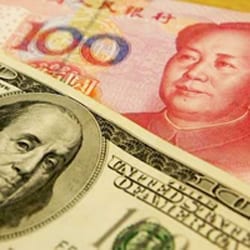Did the Shanghai G-20 meeting lead to a secret agreement to push the major currencies back toward their 2014 levels? Gavyn Davies in Monday’s Financial Times very accurately painted the current U.S.-China monetary/exchange rate policy approaches as not so much a new Plaza Accord but as a meeting of the minds. Markets and conspiracy theorists are even further off base in imagining a broader group of countries collaborating. The yen and the euro may have moved consistently in step with the benign currency correction noted by conspiracy theorists, but the Japanese and Eurozone governments have been anything but happy with this development.
Traders looking for signs of government machinations have had a lot to chew on since the Feb. 27 Shanghai meeting. Through January, capital poured out of China at an unsustainable pace. The Chinese government faced the bad choices dictated by the impossible trinity of monetary policy: devaluation, capital controls or higher Chinese interest rates relative to the rest of the world. With no room to raise domestic interest rates, no appetite for capital controls and a pledge not to devalue, the Chinese desperately needed help from the U.S. Federal Reserve to keep the yuan stable.
The Chinese economy and financial markets are important enough to the U.S. that the Fed pays attention. Plus, the weaker dollar that resulted from looser monetary policy will help sustain U.S. exports and economic expansion. After the Fed’s forward guidance indicated a slower pace of rate hikes, the dollar has weakened and pressure on the yuan abated. David Smick, publisher of International Economy magazine, noted that the new Plaza theory attributes the Chinese role in the deal to its currency basket target, which involved selling dollars and buying euros and yen.
Adding to the conspiracy tease was new language in the Shanghai G-20 communiqué, agreeing to “refrain from competitive devaluations” and “not target our exchange rates for competitive purposes.” This suggests a wider discussion on managing exchange rates might have happened. I disagree with Davies and Jeff Frankel that the language precludes coordinated intervention, constituting an “anti-Plaza.” Rather, Fred Bergsten has the right interpretation, that the G-7 and G-20 language only targets individual countries’ actions. Coordinated joint management of currencies falls well within the bounds of acceptability.
Was there some behind the scenes agreement, then? We cannot know, but Larry Summers is quite convincing (and funny) in shooting down the conspiracy theory. First, governments aren’t inherently well-suited to back-room market manipulation. Second, Summers echoed Davies’ point that the more likely scenario is a lucky coincidence of interests between the U.S. and China.
Beyond those two countries, comparisons with the Plaza Accord crash hard against the discord over the yen. The Bank of Japan is clearly unhappy with the yen’s strengthening since January, identifying it as a key focus of monetary policy. Despite Prime Minister Shinzo Abe’s recent disavowal of exchange rate intervention, Finance Minister Taro Aso wants to continue to threaten markets with it, to the displeasure of U.S. Treasury Secretary Jack Lew.
The Eurozone has stayed much farther away from managing the euro than Japan has with the yen. Yet clearly, the European Central Bank’s monetary policy is moving in only one direction at the moment, which would tend to weaken the euro. Unlike in 1985, there is no large fear of U.S. protectionism that would motivate the Eurozone or Japan to move against their own interests and facilitate the strengthening of their currencies.
In this context, a new Plaza is inconceivable. Even a G-2 arrangement between the United States and China is unlikely, though not a bad idea.
Rather, it is more likely that the shift in Chinese exchange rate management — from preventing appreciation to preventing depreciation — eliminated the key opposition within the G-20 for language against manipulating exchange rates. Indeed, the rest of Asia — which might have otherwise wanted to reserve the right to currency intervention — probably sought to contain more overt Japanese efforts to weaken the yen. The U.S. was wise to jump on this opportunity to garner wider official support for eschewing competitive exchange rate policy. Collaboration at the G-20 to isolate Japan is likely the extent of any international plan to manage exchange rates.
Russell A. Green is the Will Clayton Fellow in International Economics.
